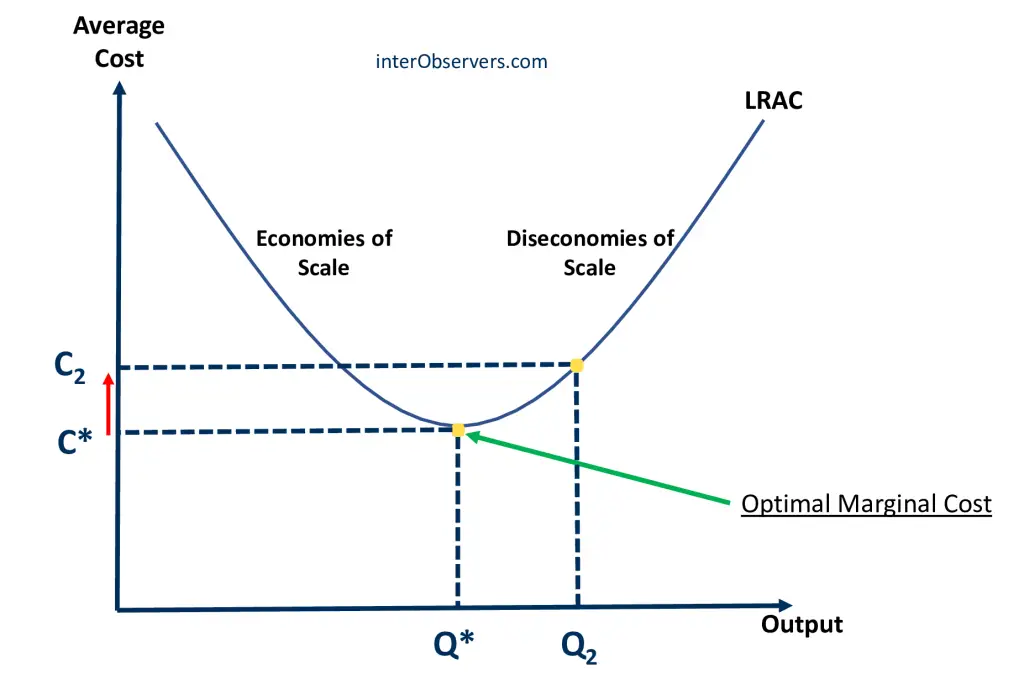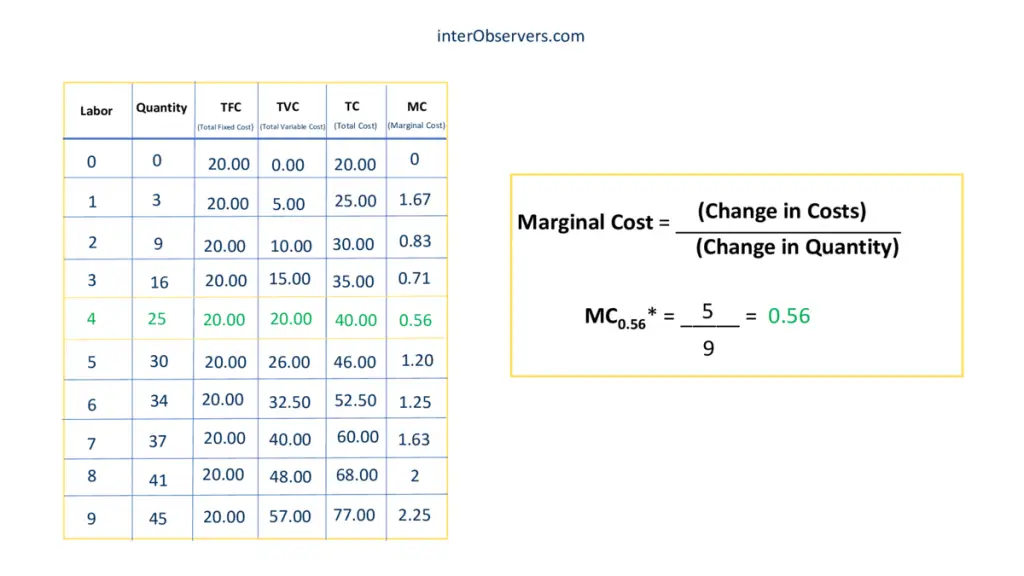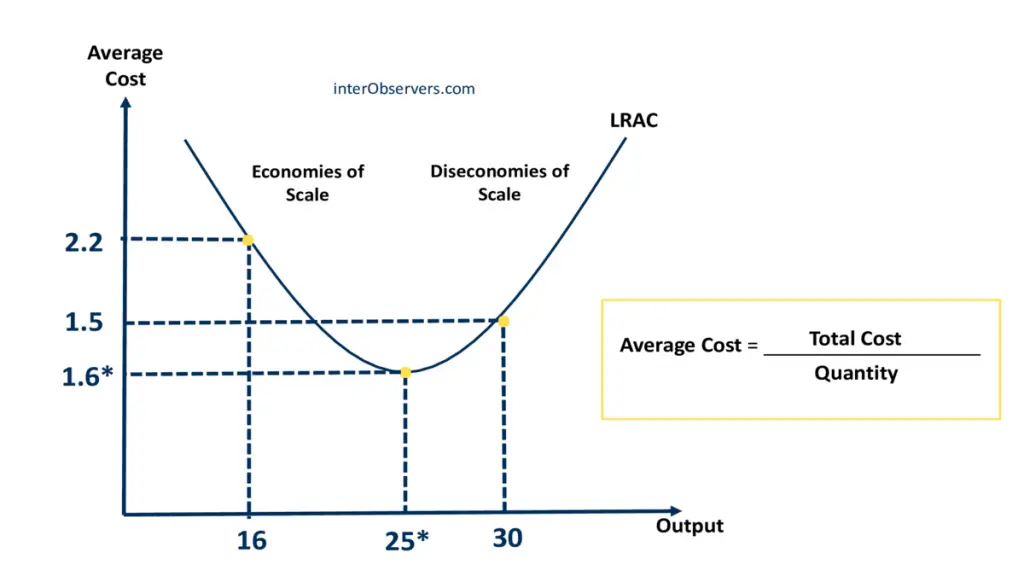Disclaimer: We sometimes use affiliate links in our content. For more information, visit our Disclaimer Page.
The diseconomy of scale is a term used to describe how profit margins decrease as a business grows in size. Many different factors can lead to this happening, some of which you may not even be aware of. In this blog post, we will go through the leading causes and how to avoid them.
What are Diseconomies of Scale?
Diseconomies of scale is an economic term that defines the trend for average costs to increase alongside output. This occurs when companies have moved beyond their optimum size and lose productive efficiency so that the costs per unit increase.
When a business grows, it can be challenging to maintain economies of scale. Diseconomies of scale occur when an additional production unit of output increases marginal costs, which results in reduced profitability. Instead of the cost decreasing as more units are produced (which happens with economies of scale), they go up!
After reaching the maximum efficiency point, any units produced will be inefficient because they increase the marginal cost per additional unit. The optimal Q* is found in our graph below.
Diseconomies of Scale Graph

The graph above shows that an increase in production beyond Q* leads to an increased average cost. This is called diseconomies of scale. The long-run average cost (LRAC) curve illustrates the effect of the diseconomies of scale.
The optimal scale for a firm’s output is marked with the letter Q*. This point at which costs per unit are at their lowest (marked C*). In a firm that grows beyond Q*, its average costs will be higher due to diseconomies of scale.
When economies of scale are present, the long-run average cost (or LRAC) decreases as output increases. We can see this clearly from our diagram. We have an increasing line for output and decreasing sidebar values that represent Average Costs over periods.
As businesses expand, they must deal with challenges such as increased workload and serving more clients. This is difficult under changing conditions because higher production might mean a loss in profitability if cost control measures aren’t implemented effectively enough to keep up with demand.
Diseconomies of Scale Example
When an organization’s output grows, it tries to reduce its marginal cost, each extra unit’s cost. As a result, it will increase efficiency by employing its resources in the most effective manner possible. Increased profits per unit will follow as a consequence of greater efficiency. When there is a diseconomy of scale, on the other hand, the marginal cost does not decline, but rather it rises.

The marginal cost (MC) rises due to an increase in quantity from 4 to 5. As shown in the graph below, economies of scale become diseconomies of scale at this point. Also, note that as the number goes up to 5, the variable cost increases, raising total costs due to overall costs.
Solution: The firm’s cost policies and operation should be reviewed to avoid becoming an easy target for rival businesses seeking to expand or acquiring market share. In addition, the company needs a more efficient technology that can raise output while minimizing expenses in order not only to survive but thrive as well!

What are the main causes of diseconomies of scale?
The types of diseconomies of scale can be split into two categories: internal and external. Internal factors are controlled by the organization itself, such as organizational structure or process management. By contrast, external diseconomies are a cost or disadvantage that comes from something outside the company, including labor shortages, natural disasters, taxes, or market conditions.
The following are the various types of diseconomies of scale broken down into these two categories.
Internal Diseconomies of Scale
Technical Diseconomies of Scale
Technical diseconomies are the result of inefficient production processes and physical limits. This usually occurs when a company cannot keep up with demand as it grows more quickly than it can scale, which happens at any point along an assembly line or even by one employee’s actions within their own workspace environment.
Purchasing Diseconomies
The company is a victim of its success. As companies grow, they can have too much cash flow and pay more than necessary for goods or services. As these firms become able to spend even more on desired assets, there is often overspending of acquiring them.
Spending too much can have a devastating effect on a company. That’s because when companies make more money, it typically means they spend even more freely and without consideration for consequences or future needs of any kind. This creates the potential for overspending in various situations and can lead to irresponsible spending, greater waste, higher costs, and lack of progress within a company.
Organizational Diseconomies of Scale
There are many reasons that the marginal cost of production might increase as an organization’s output increases. One reason could be managerial inefficiency, bureaucracy, ineffective maintenance of equipment, and employee motivation. All of these lead to the firm’s inefficiency, which causes a rise in marginal costs as output increases.
As a company grows, it is difficult to pinpoint where inefficiencies may come from. For example, they may face inefficiency with increasing scales, such as communication problems, management issues, and even cultural clashes between employees who don’t get along well. Disadvantages like these may be difficult for managers to spot because there are so many other things going on at once within large firms; it’s not easy to identify where an organizational diseconomy might originate from if you have a big team working together under one roof.
Competitive Diseconomies
In competitive markets where there is intense competition, companies face the risk of becoming obsolete. This makes them more motivated to keep their operations efficient and costs low. Still, in markets without much competition or pressure from others outside the company, they can become too inefficient when diseconomies of scale come into play.
Diseconomies of Scope
A business can become less efficient if it starts to spread itself too thin. Diseconomies of scale might be more evident than diseconomies of scope. However, this one is still worth noting because the negative impacts are just as severe. Diseconomy of scope occurs when a company expands its services or products beyond what they originally offered and starts competing with other companies in their industry.
This leads to increased costs that could have been avoided had they stayed focused on their original market. Even worse, expansion into new markets requires additional research and development, which creates an opportunity cost for them; time spent expanding means less time spent growing existing operations.
Diseconomy of Specialization
This refers to the negative impact of having employees specialize in specific tasks, common among large companies with separate departments for specific roles or functions. Disadvantageous results from this might include a low motivation and satisfaction within an employee who has been doing the same thing day after day without receiving any reward for their efforts. It may also make them less creative over time since they’re not using different parts of their brains anymore.
Diseconomies like these become more common when businesses grow larger because it becomes harder for managers to keep track of the different activities that are taking place within their organization. As a result, the Diseconomy of specialization can lead to apathy, dissatisfaction, and even lack of motivation in employees who may feel they’re not using the full range of their skills or talents any longer.
Diseconomies Due to Poor Planning
This refers to diseconomies that come about because a company failed to properly plan for future growth before expanding too quickly on impulse rather than making calculated decisions based on reason and logic. Disadvantages like these become more common when businesses grow larger because it becomes harder for managers who oversee multiple locations at once.
This means there might be less attention given toward expansion plans that would otherwise have prevented such from arising in the first place. Diseconomies due to poor planning can lead to market stagnation, which is bad news for businesses that don’t adapt quickly enough in an ever-changing world.
How to Avoid Diseconomies of Scale in Business?
How do you know if your business is experiencing diseconomies of scale? When a company’s average cost per unit increases as the number of units produced increases, this can indicate that they are inefficiently using resources or following outdated practices in some way.

Suppose your organization is experiencing diseconomies of scale. In that case, you’ll need to take steps toward right-sizing operations by improving efficiency and adapting to a changing market.
Diseconomies of scale can result from many different factors, including increased management costs that increase size, infrastructure inefficiencies caused by an inability to adapt to change quickly enough, or poor production planning because managers are too far removed from day-to-day operations.
There are several ways you can avoid diseconomies of scale:
• Improve supply chain processes – Diseconomies occur when it’s difficult for employees at different levels within the company (from plant workers on the floor all way up to senior management) to communicate effectively about supply chain issues such as demand forecasts and fulfillment timing. Ensure information flows freely between departments so everyone is together toward common goals and there’s a shared understanding of departmental roles.
• Improve financial management – Diseconomies often occur when an organization outgrows its existing facilities or fails to make necessary updates to equipment or infrastructure, which leads to more expensive operating costs and longer wait times for delivery of products due to under-capacity production lines. Diseconomies will be much less likely if you’re able to budget effectively in both the short term (e.g., reallocating funds within current budgets) and long term (for example, developing plans that ensure future financial stability).
• Improve communication – Diseconomies are more likely to happen in organizations with poor communication across organizational levels, leading some managers to miss out on opportunities while others waste time reinventing the wheel. This can be minimized by ensuring proper channels exist so that all staff members have access to pertinent information needed for their jobs (e.g., cross-functional teams).
• Optimize workforce – Diseconomies can also occur when a business is so large that employees at all levels have difficulty finding opportunities to learn and grow their skillsets, which leads them to become disengaged from the organization as a whole. Ensure there are comprehensive training programs (job enrichment) in place for all staff members, so they’re encouraged to develop new abilities and feel valued by their employer. In addition, make sure managers know how best to manage remote workers via technologies such as video conferencing tools or instant messaging apps. Diseconomies will be much less likely if employees at every level feel engaged with one another toward common goals.
• Optimize management structure – Diseconomies can also occur when the traditional hierarchy within a company creates barriers between departments or divisions that work toward common goals, such as marketing and customer service. In addition, diseconomies are more likely to happen in organizations with little communication across organizational levels, leading some managers to miss out on opportunities while others waste time reinventing the wheel because they lack essential information from other parts of the organization (e.g., new product features).
Ensure proper channels exist, so all employees at every level have access to pertinent information needed for their jobs. This could mean establishing cross-functional teams, where employees from several departments come together to complete projects such as new product development. Diseconomies will be much less likely if a shared understanding of departmental roles and information flows freely between all levels within an organization.
• Finally, ensure you’re able to measure your progress toward these goals – Diseconomies occur when it’s difficult for executives at different levels within the company (from the chief executive officer to the frontline staff) to measure performance and make accurate business decisions. Diseconomies can be minimized if your organization can track key metrics such as total cost of ownership (TCO), return on investment (ROI), or customer satisfaction levels for all departments and divisions involved in a project, product line, or supply chain process. In addition, diseconomies will be much less likely if you’re able to accurately monitor your progress toward organizational goals and take action when needed.
Related Article: How to Create an Outstanding Lean Management Plan
External Diseconomies of Scale
External diseconomies of scale happen when a company has to deal with factors outside its business realm. External causes can include increased taxes, changes in labor laws, and higher costs due to environmental regulations. Externalities may be out of your control, but there are steps you can take within your control to minimize their effect on your bottom line. The three types of external diseconomies can be divided into three broad categories:
Social Diseconomies of scale
Diseconomies of scale in the form of social diseconomies can be found when an industry’s growth effects or harms people. Diseconomies due to this reason may include environmental concerns such as air pollution, water contamination, and waste disposal. Social Diseconomies also happen when companies operate in ways that infringe labor rights and interfere with local communities’ well-being.
Governmental Diseconomies of Scale
These are related to issues caused by government regulations such as stricter environmental policies, safety laws, etc. Government regulation often results in higher costs for businesses that have difficulty adjusting their business practices accordingly.
Environmental Diseconomy of Scale
The third major factor behind external diseconomies is pollution during production processes or waste disposal methods larger than smaller businesses. Regulations regarding efforts raise operating costs over time, making it difficult for a company to maintain profitability.
What Can You Do to Minimize External Diseconomies of Scale?
External diseconomies will always be present in growing companies. However, there are steps you can take to mitigate their effects on the company’s bottom line:
• Minimize environmental impact – Conserve energy by installing motion sensors in the lighting system. Also, use water-efficient systems whenever possible. Use less packaging, recycle materials and reuse packing materials.
• Ensure that every staff member follows high environmental standards by training staff members, provide safe working conditions, and ensure proper recycling procedures.
• Investigate all legal issues surrounding potential damage before expanding into new markets. If necessary, hire an attorney experienced in these matters.
• Ensure your company’s safety procedures are always followed and regularly updated – Invest in a risk assessment to ensure all operations have been thoroughly analyzed, including production lines or any other areas where accidents could happen.
• Invest in technology – If you need to be more efficient, invest in the latest resources that can save your business money. External diseconomies of scale should not hold back company growth and development if they are managed carefully. Of course, externalities exist, but there is always a way around them with careful planning and preparation.
Related Terms:
Conclusion
This blog post discussed how many different factors can decrease profit margins as a business grows. If you have noticed that your company is no longer making as much money as it used to be, there may be something going on behind the scenes that need fixing.
We hope these tips will help you avoid or fix some of those issues so your organization can continue being profitable and successful! And if you’ve found it helpful or insightful in any way, please share and subscribe so we can continue to provide more content like this!
Frequently Asked Questions
When Diseconomies of Scale Occur?
Diseconomies of scale happen to a company when it expands its business too quickly. Diseconomies occur because companies do not have the means or knowledge necessary to manage their growth properly. As such, costs rise, creating inefficiency, reducing quality, and low morale among employees.
What are Diseconomies of Scale?
Diseconomies of scale are the phenomenon in which increased production results in higher average costs. Diseconomies of scale can be caused by many factors, such as management or operational problems.
Economies and Diseconomies of Scale
A diseconomy is a situation in which production efficiency decreases as production levels rise beyond optimal levels. When a firm’s operations become more efficient, economies of scale result in cost advantages. Diseconomies of scale are the opposites of these benefits, increasing costs as output rises.





